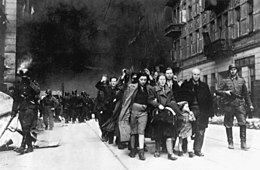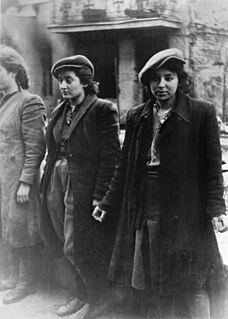| Ghetto uprisings | |
|---|---|
  Top: members of the United Partisan Organization (FPO) in the Vilna Ghetto, one of the first armed resistance organizations established in the Nazi ghettos during World War II. Bottom: captured Jews during Warsaw Ghetto Uprising led by the Germans for deportation to death camps. Picture taken at Nowolipie street, near the intersection with Smocza | |
| Location | German-occupied Europe |
| Date | 1941–43, World War II |
| Incident type | Armed revolt |
The ghetto uprisings during World War II were a series of armed revolts against the regime of Nazi Germany between 1941 and 1943 in the newly established Jewish ghettos across Nazi-occupied Europe. Following the German and Soviet invasion of Poland in September 1939, Polish Jews were targeted from the outset. Within months inside occupied Poland, the Germans created hundreds of ghettos in which they forced the Jews to live. The new ghettos were part of the German official policy of removing Jews from public life with the aim of economic exploitation. [1] The combination of excess numbers of inmates, unsanitary conditions and lack of food resulted in a high death rate among them. [2] In most cities the Jewish underground resistance movements developed almost instantly, although ghettoization had severely limited their access to resources. [3]

World War II, also known as the Second World War, was a global war that lasted from 1939 to 1945. The vast majority of the world's countries—including all the great powers—eventually formed two opposing military alliances: the Allies and the Axis. A state of total war emerged, directly involving more than 100 million people from over 30 countries. The major participants threw their entire economic, industrial, and scientific capabilities behind the war effort, blurring the distinction between civilian and military resources. World War II was the deadliest conflict in human history, marked by 50 to 85 million fatalities, most of whom were civilians in the Soviet Union and China. It included massacres, the genocide of the Holocaust, strategic bombing, premeditated death from starvation and disease, and the only use of nuclear weapons in war.

Nazi Germany is the common English name for Germany between 1933 and 1945, when Adolf Hitler and his Nazi Party (NSDAP) controlled the country through a dictatorship. Under Hitler's rule, Germany was transformed into a totalitarian state that controlled nearly all aspects of life via the Gleichschaltung legal process. The official name of the state was Deutsches Reich until 1943 and Großdeutsches Reich from 1943 to 1945. Nazi Germany is also known as the Third Reich, meaning "Third Realm" or "Third Empire", the first two being the Holy Roman Empire (800–1806) and the German Empire (1871–1918). The Nazi regime ended after the Allies defeated Germany in May 1945, ending World War II in Europe.

The Invasion of Poland, known in Poland as the September Campaign or the 1939 Defensive War, and in Germany as the Poland Campaign (Polenfeldzug), was an invasion of Poland by Germany that marked the beginning of World War II. The German invasion began on 1 September 1939, one week after the signing of the Molotov–Ribbentrop Pact between Germany and the Soviet Union. The Soviets invaded Poland on 17 September following the Molotov–Tōgō agreement that terminated the Soviet and Japanese Battles of Khalkhin Gol in the east on 16 September. The campaign ended on 6 October with Germany and the Soviet Union dividing and annexing the whole of Poland under the terms of the German–Soviet Frontier Treaty.
Contents
The ghetto fighters took up arms during the most deadly phase of the Holocaust known as Operation Reinhard (launched in 1942), against the Nazi plans to deport all prisoners – men, women and children – to camps, with the aim of their mass extermination. [3]

The Holocaust, also known as the Shoah, was a genocide during World War II in which Nazi Germany, aided by local collaborators, systematically murdered some six million European Jews—around two-thirds of the Jewish population of Europe—between 1941 and 1945. Jews were targeted for extermination as part of a larger event during the Holocaust era, in which Germany and its collaborators persecuted and murdered other groups, including Slavs, the Roma, the "incurably sick", political and religious dissenters such as communists and Jehovah's Witnesses, and gay men. Taking into account all the victims of Nazi persecution, the death toll rises to over 17 million.

Operation Reinhard or Operation Reinhardt was the codename of the secretive World War II German plan to exterminate Poland's Jews in the General Government district of German-occupied Poland. This deadliest phase of the Holocaust was marked by the introduction of extermination camps.

Nazi Germany built extermination camps during the Holocaust in World War II, to systematically kill millions of Jews, Slavs, Poles, Roma, Soviet POWs, political opponents and others whom the Nazis considered "Untermenschen" ("subhumans"). The victims of death camps were primarily killed by gassing, either in permanent installations constructed for this specific purpose, or by means of gas vans. Some Nazi camps, such as Auschwitz and Majdanek, served a dual purpose before the end of the war in 1945: extermination by poison gas, but also through extreme work under starvation conditions.
























